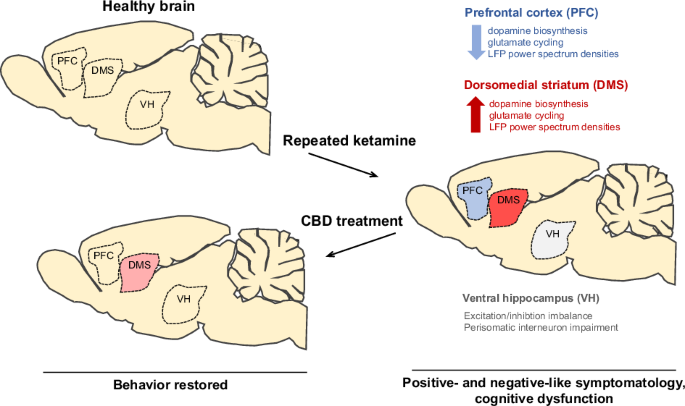
“Although alcohol use disorder (AUD) is highly prevalent, only a few medications are approved for its treatment leaving much room for improvement. Cannabidiol (CBD) might be a particularly promising candidate, with preclinical data suggesting that CBD is effective in targeting AUD symptoms and disease processes that drive alcohol use and relapse, due to its anti-craving, stress-reducing, and anti-compulsive effects.
Here we report data from the double-blind randomized controlled ICONIC trial that compared the effects of a single dose of 800 mg cannabidiol against placebo (PLC) in N = 28 individuals with AUD. Cue-induced nucleus accumbens (NAc) activation, alcohol craving during a combined stress- and alcohol cue exposure session, as well as craving during an fMRI alcohol cue-reactivity task and CBD plasma levels served as outcomes.
Individuals receiving CBD showed lower bilateral cue-induced NAc activation (tleft_NAc(23) = 4.906, p < 0.001, d = 1.15; tright_NAc (23) = 4.873, p < 0.001, d = 1.13) and reported significantly lower alcohol craving after a combined stress- and alcohol cue exposure session (Fgroup(1,26) = 4.516, p = 0.043, eta2 = 0.15) and during the fMRI cue-reactivity task (Fgroup(1,24) = 6.665, p = 0.015, eta2 = 0.23). CBD levels were significantly higher in the CBD group (t(25) = 3.808, p < 0.001, d = 1.47) and showed a significant negative association with alcohol craving during the cue exposure experiment (r = -0.394, pFDR = 0.030) and during fMRI (r = -0.389, pFDR = 0.030), and with left and right NAc activation (rleft_NAc = -0.459, pFDR = 0.030; rright_NAc = -0.405, pFDR = 0.030).
CBD’s capacity to reduce stress- and cue-induced alcohol craving and to normalize NAc activation – a region critical to the pathophysiology of AUD – contribute to understanding the neurobiological basis of its clinical effects and support its potential as a treatment option for AUD.”
https://pubmed.ncbi.nlm.nih.gov/39668256/
“In summary, the observed potential of CBD to reduce cue-induced NAc activity and alcohol craving, together with its good safety profile, supports the potential of CBD to treat individuals with AUD. New pharmacological treatment options that target central neurobiological disease mechanisms and core symptoms of AUD, such as craving, could complement existing treatment options and reduce relapse risk and the enormous disease burden inflicted by AUD.”



